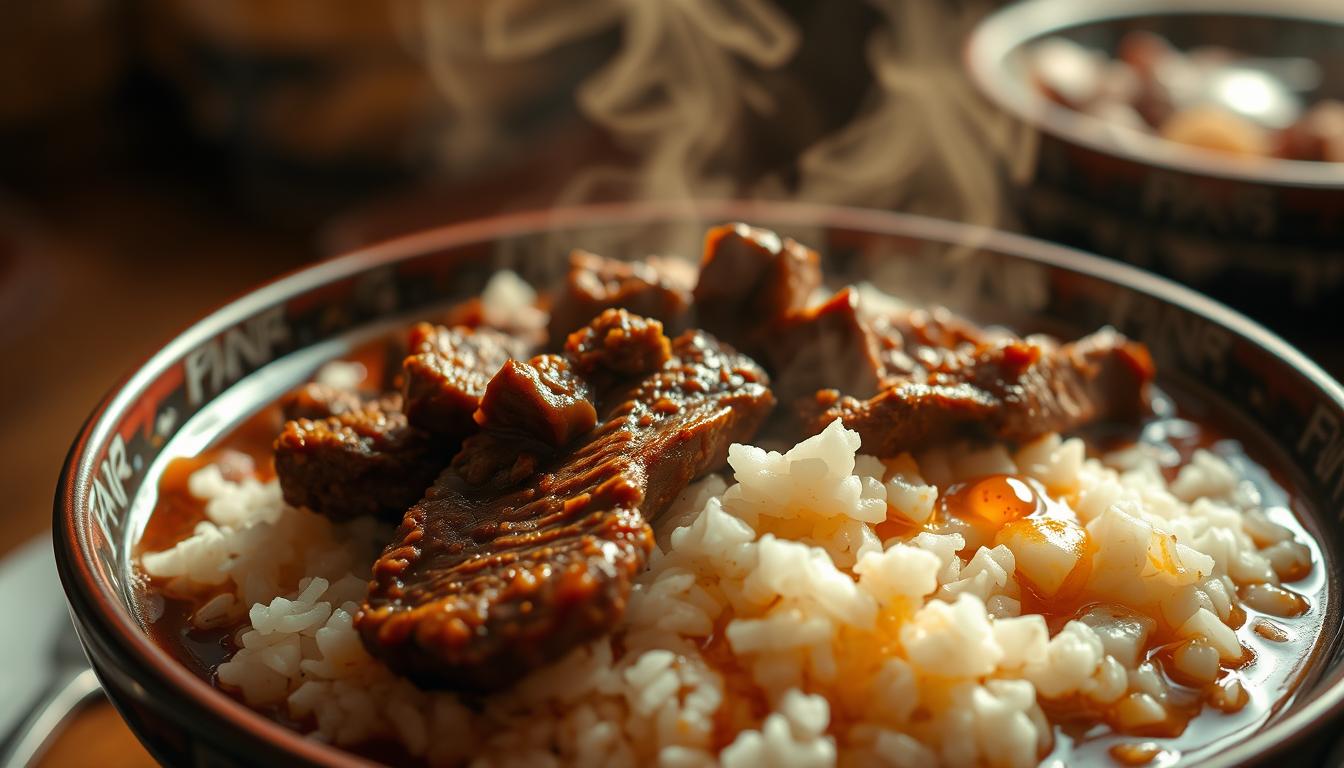Authentic Beef Pares Recipe: Tender Meat, Savory Sauce
Have you ever wondered what makes a dish truly unforgettable? It’s not just the flavors but the stories and traditions behind it. This is where beef pares shines—a beloved Filipino comfort food with deep cultural roots and a savory, aromatic sauce that warms the soul.
Originating from the bustling streets of the Philippines, this dish blends Chinese influences with local flavors. Traditionally served as an after-school snack, it’s a meal that evokes warmth and nostalgia. The tender meat, simmered in a rich broth with garlic, ginger, and star anise, creates a harmony of flavors that’s hard to resist.
In this article, you’ll discover the secrets to crafting this iconic dish. From selecting the right ingredients to mastering the cooking techniques, we’ll guide you step by step. Whether you’re a seasoned cook or a beginner, this guide will help you bring a piece of Filipino tradition to your table.
Key Takeaways : Beef Pares Recipe
- Beef pares is a cherished Filipino dish with Chinese influences.
- It features tender meat and a savory, aromatic sauce.
- The dish is often associated with warm, nostalgic memories.
- Key ingredients include garlic, ginger, and star anise.
- This guide provides step-by-step instructions for perfect results.
Ingredient Spotlight for Beef Pares Recipe
Every great meal starts with the right components. For this dish, the ingredients are carefully chosen to create a balance of flavors. Fresh aromatics like garlic, ginger, and onion build the foundation, while spices like star anise add depth.
The savory-sweet sauce is a blend of soy sauce, sugar, and broth, simmered to perfection. Each component plays a vital role in achieving the dish’s signature taste.
Featured Ingredients and Spices
Here’s a closer look at the key ingredients that make this dish stand out:
| Ingredient | Role |
|---|---|
| Garlic | Adds a robust, aromatic base. |
| Ginger | Provides warmth and a hint of spice. |
| Star Anise | Infuses a licorice-like sweetness. |
| Soy Sauce | Delivers umami and saltiness. |
| Broth | Creates a rich, flavorful base. |
Ingredient Substitutions and Tips
If you can’t find brisket, try using flank or shank. These cuts also yield tender results when cooked slowly. Fresh ingredients are key, so avoid pre-minced garlic or powdered ginger for the best flavor.
Adjust the seasoning to your taste. Add more sugar for sweetness or extra soy sauce for a saltier profile. Cooking is all about making it your own.
Step-by-Step Cooking Process
Mastering the art of cooking this dish requires attention to detail and patience. Each step builds on the last, creating layers of flavor that make the meal unforgettable. Let’s dive into the process.
Preparing and Browning the Beef
Start by seasoning your brisket with salt and pepper. Heat a pan with a tablespoon of oil over medium-high heat. Add the beef and sear it until it’s browned on all sides. This step locks in the juices and adds depth to the flavor.
Simmering and Reducing the Sauce
Once the beef is browned, remove it from the pan. In the same pan, sauté garlic, ginger, and onion until fragrant. Return the beef to the pan and add star anise, soy sauce, and a generous pinch of sugar. Pour in enough broth to cover the meat and let it simmer for 1½ to 2 hours, or until tender.
Crafting the Perfect Fried Rice and Broth
While the beef simmers, prepare the fried rice. Sauté minced garlic in a hot pan, then add cooked rice and stir until evenly coated. For the broth, heat it separately and season with a pinch of salt and pepper. Serve the beef with the rice and a side of warm broth for a complete meal.
Cultural and Historical Context of Beef Pares
Culinary traditions often carry the weight of history and culture. This dish is no exception. Its roots trace back to the Philippines, where it evolved as a blend of local flavors and Chinese influences. The result is a meal that’s deeply embedded in Filipino comfort food culture.
Filipino and Chinese Culinary Influences
The dish reflects a unique fusion of Filipino and Chinese cooking techniques. Ingredients like garlic, ginger, and star anise showcase Chinese culinary traditions. These elements were adapted to local tastes, creating a dish that’s both familiar and distinct.
In the Philippines, this meal became a staple in street-side eateries. It’s often served with a side of fried rice and a warm broth, making it a complete and satisfying meal. This combination highlights the practicality and resourcefulness of Filipino cuisine.
Traditions Behind the Recipe
For many, this dish is more than just food—it’s a connection to family and tradition. Stories shared on platforms like Sago Show reveal how it evokes warm, nostalgic memories. Families often gather around the table to enjoy this meal, passing down recipes through generations.
Its popularity in street food scenes further cements its place in Filipino culture. Whether enjoyed after school or as a late-night snack, it’s a dish that brings people together.
| Cultural Element | Description |
|---|---|
| Chinese Influence | Use of spices like star anise and ginger. |
| Filipino Adaptation | Incorporation of local ingredients and serving styles. |
| Family Traditions | Recipes passed down through generations. |
| Street Food Culture | Widely available in street-side eateries. |
Conclusion
Bringing a piece of Filipino tradition to your kitchen is easier than you think. By following the steps outlined, you can create a dish that’s rich in flavor and history. Start with quality ingredients like fresh garlic and simmer the meat in a savory broth to achieve tender, mouthwatering results.
This meal is more than just food—it’s a celebration of culture. Its roots in Filipino and Chinese culinary traditions make it a unique and meaningful addition to your table. Feel free to experiment with substitutions and presentation to make it your own.
Ready to embrace this flavorful journey? Try the recipe, share your experience, and savor the heritage behind every bite. Your kitchen is the perfect place to explore new traditions and create lasting memories.







